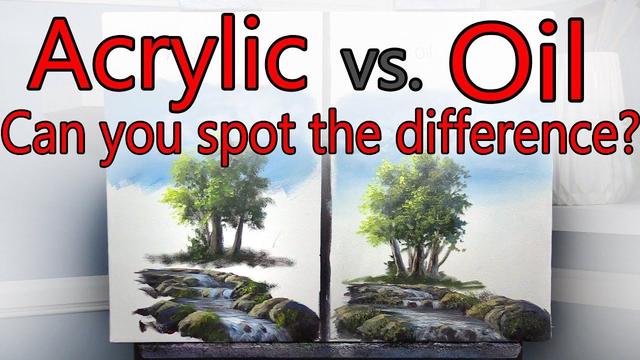Oil paint and acrylics are two popular painting mediums for artists, but which one should you use for your work? Each has its own properties that give it specific advantages and disadvantages, suiting it to some painting approaches more than others.
Both types of paint come in artists' and professional ranges, which mark intermediate and high-end quality, as opposed to cheaper student quality. It is important to pick good quality paint, such as those in our guide to the best oil paints. It is also a good idea to work at an easel in both oils and acrylics – check out our best easel lowdown if you need to get one – as it gives the arm lots of room for expressive brushstrokes and helps prevent the hand from smearing the painting. And you'll also want a quality canvas so check out our favourites in the best canvas for oil paints guide.
Acrylics vs oils: drying Times
One of the most well-known differences between acrylics and oils is how long each takes to dry. Acrylics are often dry to the touch within minutes, whereas oils take days to weeks, and need months to years to truly dry out. This is because oils don't evaporate like water, but gradually polymerise into a solid.
Whether this is good or bad is more a personal preference. Acrylics might suit an approach that utilises the fast drying times to add lots of layers, whereas oils might work better for approaches that incorporate blending or more spontaneous brushwork.
Drying times are not set in stone either. Various agents can be added to acrylic paint to extend drying times, and 'open' acrylic paints like Golden's Open range (https://www.cassart.co.uk/golden-category/golden-open-acrylic/golden-open-acrylic-paint.htm / https://www.dickblick.com/products/golden-open-acrylics/) offer slower drying times. The drying time of oil paint can be accelerated with mediums, such as Winsor and Newton's Liquin (https://www.cassart.co.uk/painting/oil-colour/product-type-medium/winsor-newton-liquin-original-medium.htm / https://www.dickblick.com/items/winsor-newton-liquin-original-75-ml-bottle/ ) or Schminke's premixed mediums (https://www.cassart.co.uk/painting/oil-colour/product-type-medium/schmincke-hilfsmittel-mussini-medium3-60ml.htm https://www.dickblick.com/items/schmincke-mussini-oil-medium-medium-3-200-ml-bottle/ ). This should be done with care, as overuse of oil mediums may negatively affect the surface and longevity of a painting.

One downside of acrylic paint's fast drying time is that tubes may dry out, especially if not well cared for. In comparison, properly sealed oils take decades to dry out.
Acrylics vs oils: versatility
The biggest strength of acrylic paint is its versatility. There is a wide range of different mediums available for acrylics that have different effects, such has making the paint glossier, giving it texture, making it runny or thick, or changing the drying time. These can be used to customise how the paint behaves. This set by Liquitex (https://www.cassart.co.uk/brand/liquitex/liquitex-basics-acrylic-mediums-75ml-set-of-5.htm / https://www.dickblick.com/products/liquitex-basics-acrylic-mediums/) contains several different mediums for manipulating acrylic paint.
Acrylic paint itself comes in several different types. These can be used alone or in combination. Besides conventional acrylics, known as soft body paint, there are heavy body paints that are as thick as oils, much thinner fluid paints, and acrylic inks. This variety means acrylics can suit many different working processes.
Acrylics vs oils: surface and colour
Acrylics have a reputation for having a dead, flat surface quality. The extra mediums and artists' quality paints available shows that this doesn't have to be true, bit it is still challenging for them to compete with oils on this front.
Oil paints naturally have a richer depth of colour, and are good at retaining textured brushstrokes as well. They don't require extra additives to do this and the surface tends to have a pleasant gloss thanks to the oil. The thickness of the paint is more tactile than acrylics as well, making it pleasant to work with.
Acrylics vs oils: which one is best for you?
Acrylics may be a better option for anyone looking for the freedom to alter the qualities of the paint, by using mediums or experimenting with the different types of acrylics, and suits layered painting approaches. They are also a good choice for anyone with children and pets around, or poor ventilation. Their simpler set up means they require a little less space than oils, and they are a bit quicker to pack away.
Oil paint tends to have a nicer surface quality than acrylics, and its longevity is well understood. It is also more forgiving than acrylics thanks to its slower drying time, so it can be a bit easier to paint with oils once you are familiar with the equipment, and they can be blended easily.
Both oil paint and acrylics are excellent options for artists. When picking between these two types of paint, the key thing to keep in mind is whether they suit your working process, and how they would fit into your studio set up.
Read more:
